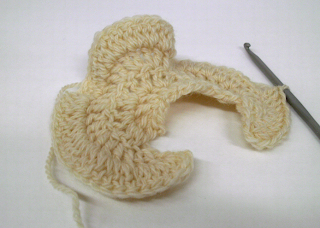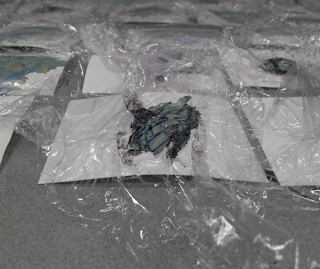Thursday, 9 February 2012
Wednesday, 8 February 2012
Systems Crochet
 |
| Grid made from yarn and pins |
 |
| (detail) |
 |
| In progress |
 |
| Finished |
 |
| Suspended from the middle point |
 |
| Worms-eye view |
ADD SCAN FROM NOTEBOOK
Crocheting with a system, mostly determined by rolling dice. Pinned to the wall as I reached each new co-ordinate. The system looked too rigid and structured, by hanging the piece I challenge the preconception of systems art. Juxtaposition of structure and natural flow/drape.
Tuesday, 7 February 2012
Hyperbolic Crochet llll
 | |
| Racetrack formation |
 |
| Curving in on itself |
 |
| Slight ruffling, due to 1 in 2 Increase |
The racetrack formation requires a specific start to enable the pattern to work:
- Ch10, turn
- 1 Treble in each
- 5 Trebles in end stitch
- Continue AROUND now using a 1 in 2 increase
- Continue increasing 1 in every 2 stitches until yarn runs out
Hyperbolic Crochet lll
 |
| Starting in a spiral formation |
 |
| Sample starting to look irregular |
 |
| Definate shape starting to emerge |
 |
| Well established sample, with the numbers that have formed it |
Crocheting in a spiral formation (round), putting a pre-determined amount of stitches into each stitch. Rolling a dice and following the numbers exactly led to this irregular sample.
Hyperbolic Crochet ll
 |
| Starting with Ch10, turn, 1 Treble into each, turn, 2 Treble in each |
 |
| Turn, 2 Treble in each stitch (repeat for the rest of the sample) |
 |
| The sample is beginning to ruffle slightly |
 |
| Sample when laid flat |
 |
| Sample allowed to curl |
 | |
| Finished sample, one ball of Rowan Pure Life DK |
Hyperbolic crochet can be worked in several different formations. Rather than working in the round, I have chosen to work in rows. Working in rows means a back and forth motion, rather than a continuous line. Turning at the end of each row gives the fabric a different texture compared to when it is worked in the round.
Subscribe to:
Posts (Atom)








